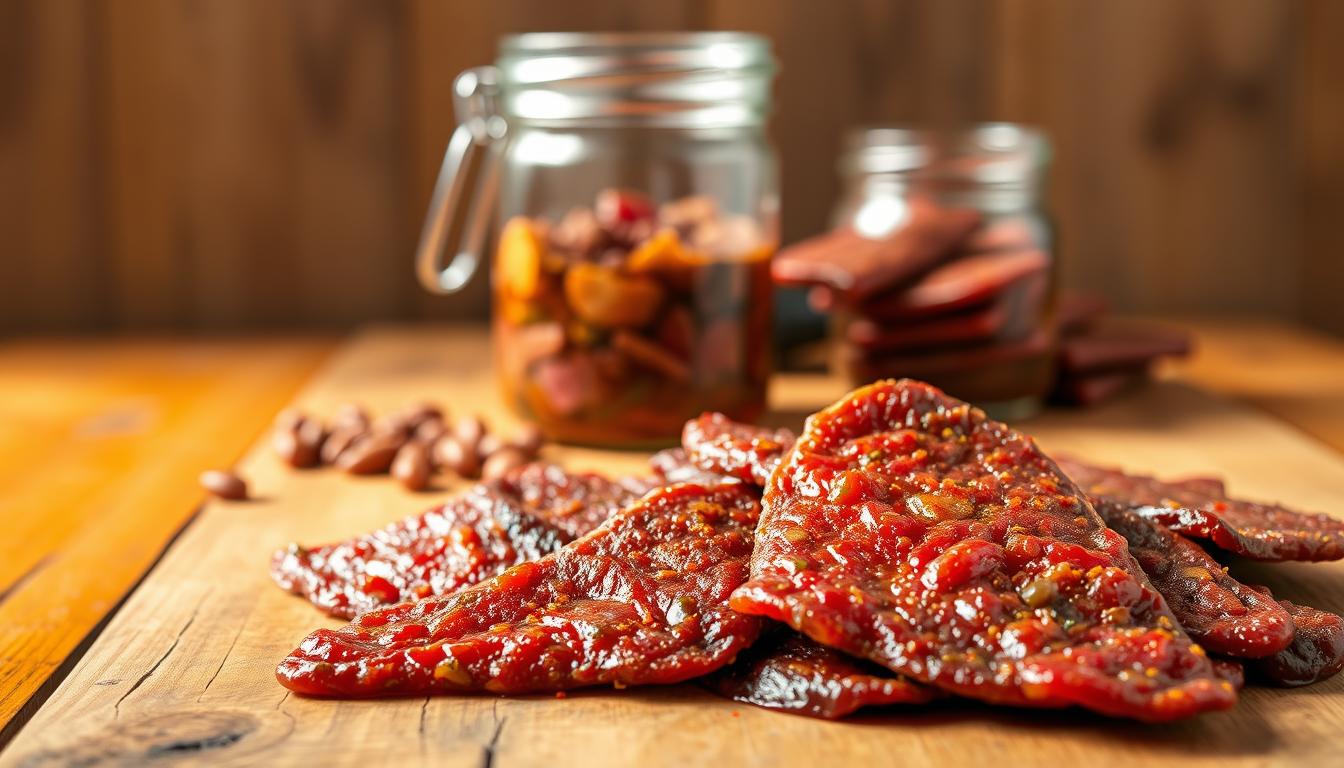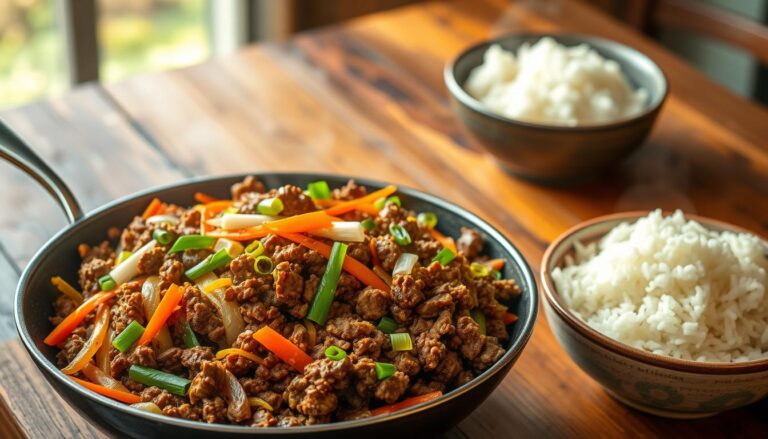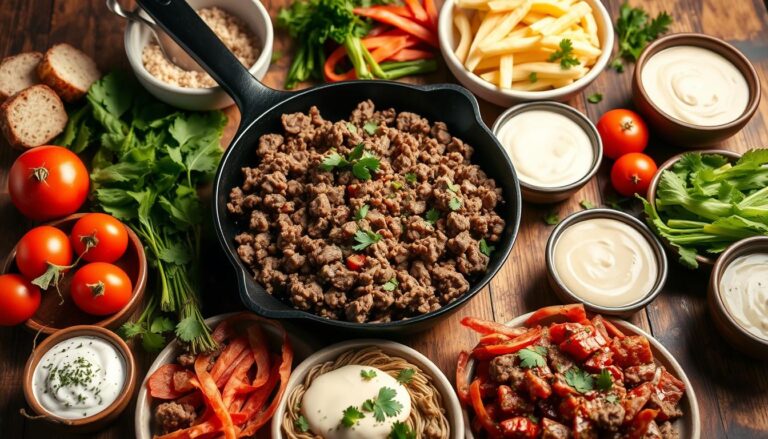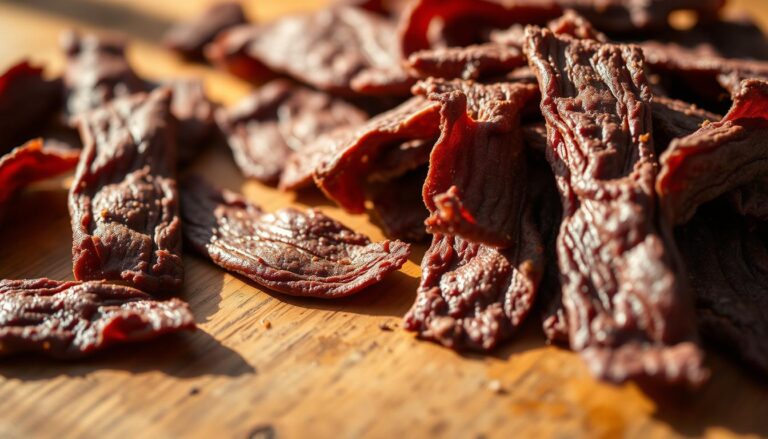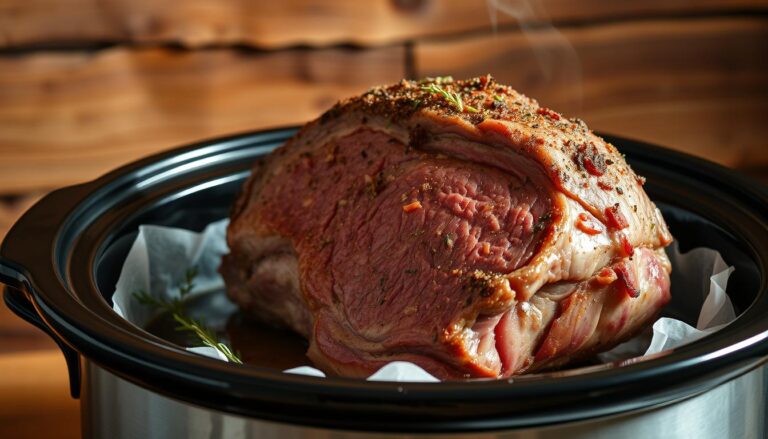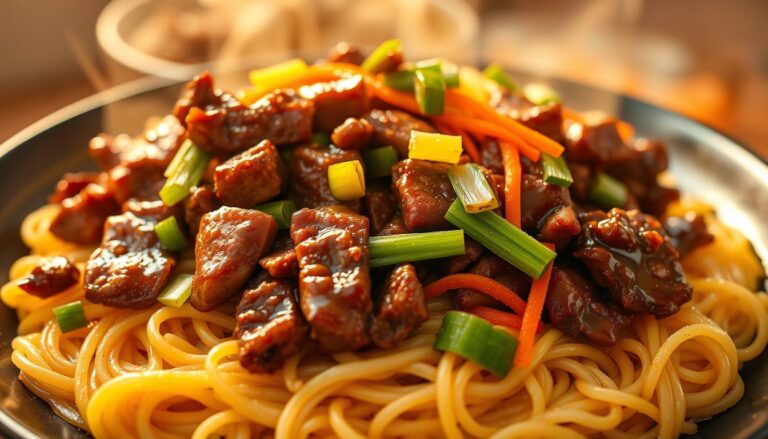How to make hamburger jerky at home – easy step-by-step recipe
Table of Contents
Looking for a tasty snack that’s easy to make? Try making hamburger jerky at home. It only needs a few ingredients and basic kitchen tools. You can enjoy it alone or with your favorite dips.
Customize the flavor to your taste with different seasonings and marinades. It’s a healthy snack that’s great for when you’re on the move. Plus, it’s a clever way to use up ground beef.
Key Takeaways
- Learn how to make hamburger jerky at home with a simple step-by-step guide.
- Customize the flavor with your favorite seasonings and marinades.
- Create a healthy snack that’s perfect for on-the-go.
- Use up ground beef and make a delicious treat.
- Enjoy beef jerky on its own or paired with your favorite dips.
What is Hamburger Jerky?
Hamburger jerky is a twist on traditional beef jerky. It’s made from ground beef, not strips. This gives it a different texture and more flavor options.
The Difference Between Traditional and Ground Beef Jerky
Traditional beef jerky is dried beef strips, cut against the grain for tenderness. Hamburger jerky, or ground beef jerky, is made from ground beef. It’s formed into strips and dried, creating a uniform texture and allowing for various flavors.
Why Hamburger Jerky is Gaining Popularity
Hamburger jerky is becoming popular for its unique texture and ease of making at home. People love controlling the ingredients and flavors. It’s a healthy, customizable snack option.
“It’s a game-changer for snack enthusiasts,” says a famous food blogger. This shows the excitement around hamburger jerky.
Benefits of Making Your Own Hamburger Jerky
Making hamburger jerky at home has many perks. You can make a snack that fits your taste perfectly. Plus, you get to enjoy the process.
Cost Savings Compared to Store-Bought Options
Homemade jerky can save you money. Buying ground beef in bulk and using what you already have can cut costs. You can save up to 50% by making it yourself.
Controlling Ingredients and Flavors
When you make your own jerky, you control everything. You can skip preservatives found in store-bought jerky. Plus, you can play with flavors and seasonings.
- Choose your preferred flavor profiles
- Avoid unwanted preservatives and additives
- Experiment with various marinades and seasonings
Nutritional Advantages of Homemade Jerky
Homemade jerky is healthier than store-bought. You can lower sodium and avoid artificial additives. It’s a great choice for a protein-rich snack.
Nutritional highlights: High protein content, customizable sodium levels, and absence of artificial preservatives.
Essential Equipment for Making Hamburger Jerky
Making ground beef jerky at home needs some key tools. The right gear makes the process smoother and more efficient. This ensures your jerky comes out just right.
Food Dehydrators vs. Oven Methods
You have two main choices for drying your jerky: a food dehydrator or your oven. A dehydrator gives consistent heat and airflow, leading to even drying. Using your oven is easier for many, as it doesn’t need extra equipment. Just set it to the lowest temperature and open the door a bit for airflow.
Necessary Tools and Accessories
Whether you use a dehydrator or oven, you’ll need some basic tools. You’ll need a mixing bowl for your ingredients, a baking sheet or trays for drying, and parchment paper or mats to prevent sticking. A meat thermometer is also handy to check the jerky’s internal temperature.
Optional Equipment for Advanced Preparation
If you want to get better at making jerky, consider some optional tools. A meat grinder or food processor can help you get a uniform texture. A vacuum sealer is also useful for keeping your jerky fresh for longer.
Selecting the Best Ground Beef for Your Jerky
Choosing the right ground beef is key to making tasty hamburger jerky at home. The type of beef you pick can change the flavor, texture, and quality of your jerky.
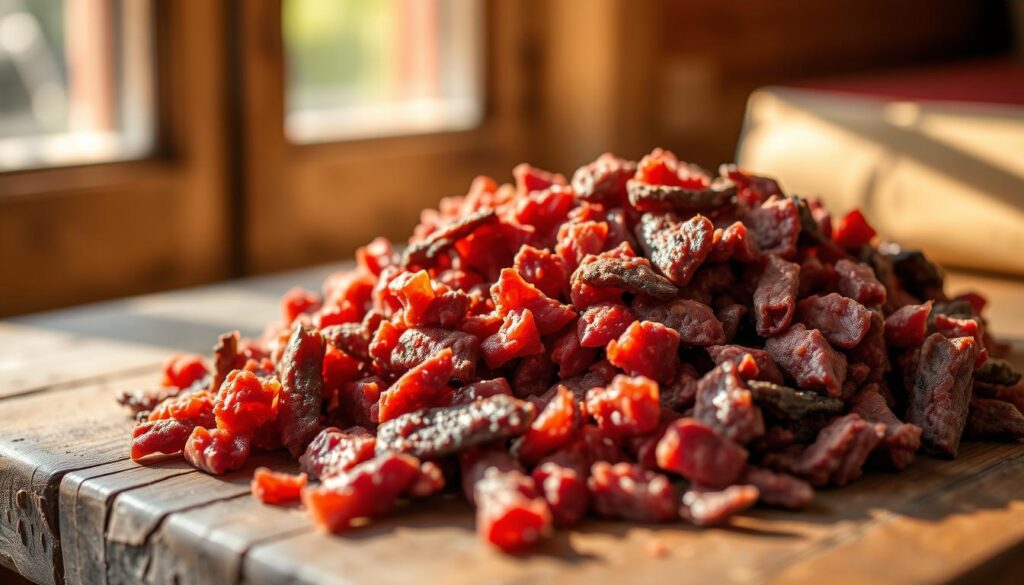
Recommended Lean-to-Fat Ratios
For minced beef jerky, a lean-to-fat ratio of 90:10 or 85:15 is best. This mix keeps your jerky from being too dry or too greasy. Lean meat makes jerky drier, while more fat can lead to spoilage.
Grass-Fed vs. Conventional Beef Considerations
Choosing between grass-fed and conventional beef for your beef jerky recipe ground beef matters. Grass-fed beef is leaner and tastes stronger. Conventional beef is fattier and tastes milder.
Budget-Friendly Options Without Sacrificing Quality
You don’t need to spend a lot to make great jerky. Look for ground beef sales or buy in bulk. You can also use cheaper cuts like chuck or round for jerky.
Complete Hamburger Jerky Recipe Ingredients
Starting your journey to make perfect hamburger jerky means picking the best ingredients. You’ll need a few key things to make tasty and safe jerky.
Basic Ingredients List
The base of your jerky is 1 pound of lean ground beef. You’ll also need some pantry staples like soy sauce, Worcestershire sauce, and brown sugar. These add flavor to your jerky.
- 1 pound lean ground beef
- 1/4 cup soy sauce
- 2 tablespoons Worcestershire sauce
- 1 tablespoon brown sugar
- 1 teaspoon smoked paprika
- 1/2 teaspoon garlic powder
- 1/2 teaspoon onion powder
- Salt and pepper to taste
Marinade Options and Flavor Enhancers
Want to add a special flavor to your jerky? Try different marinades. Use teriyaki sauce for a sweeter taste or hot sauce for a spicy twist.
Preservatives and Food Safety Additives
To keep your jerky safe, think about using sodium nitrite. It stops bacteria and keeps it fresh. Always follow safe drying and canning methods.
Choosing the right ingredients and preservatives makes your homemade hamburger jerky both tasty and safe.
Preparing Your Ground Beef for Jerky Making
The secret to amazing ground beef jerky is in the preparation. You need to prepare your ground beef right to make sure it tastes great and is safe to eat. Let’s go over how to get your ground beef ready for jerky making.
Mixing and Seasoning Techniques
First, mix your ground beef with your favorite seasonings. This is your chance to experiment with different tastes. Use a big bowl to mix the ground beef with your marinade. Make sure to mix well so the flavors spread out evenly. You can use your hands or a spoon, whichever feels better.
Some favorite seasonings for ground beef jerky include:
- Classic beef jerky seasoning with soy sauce, garlic, and black pepper
- Spicy seasoning with chili flakes and paprika
- Asian-inspired flavors with ginger and sesame oil
Forming Consistent Jerky Strips
Once you’ve mixed and seasoned your ground beef, it’s time to shape it into strips. You can shape it by hand or use a jerky gun for even strips. If shaping by hand, make long, thin strips about 1/4 inch thick. Try to make the strips the same size so they dry evenly.
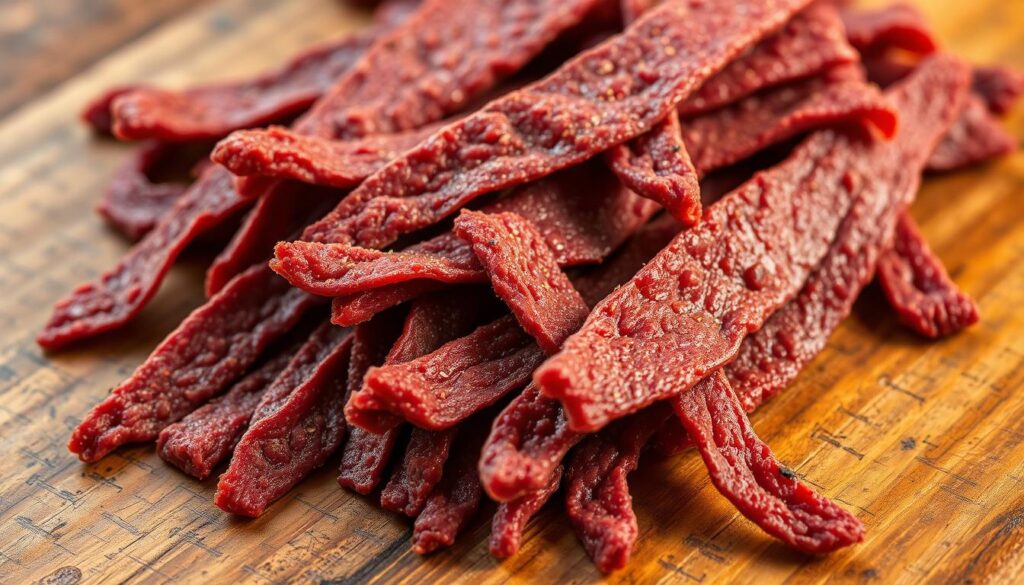
Pre-Cooking Considerations for Food Safety
Before drying your jerky, think about food safety. Ground beef can have bacteria like E. coli, which is dangerous if not handled right. To keep it safe, mix the ground beef with ingredients that kill bacteria, like soy sauce or vinegar. Also, handle the meat safely and keep it cold until you’re ready to dry it.
By following these steps, you’ll be on your way to making tasty and safe ground beef jerky at home. Remember, the secret to great jerky is in the preparation.
The Ultimate Hamburger Jerky Recipe Step-by-Step
Follow this guide to make tasty hamburger jerky at home. It’s a fun process that lets you pick the ingredients and flavors. This way, you get a healthy snack that tastes just right to you.
Mixing and Marinating Process
Start by mixing ground beef with seasonings and marinade. In a big bowl, mix 1 pound of lean ground beef with your favorite marinade. This can include soy sauce, Worcestershire sauce, and spices. Mix everything well until the meat is fully coated.
Let the meat marinate for at least 4 hours or overnight. This step is key for getting the meat’s flavor deep inside. It makes the jerky taste amazing.
Forming and Shaping the Meat
After marinating, shape the meat into strips. You can use your hands or a jerky gun for even strips. If by hand, shape small portions into thin strips, about 1/4 inch thick.
Chill the meat in the fridge for 30 minutes before shaping. This makes the meat easier to handle.
Drying Times and Temperature Guidelines
Drying is a key step in making jerky. You can use a food dehydrator or a low oven setting.
Using a Food Dehydrator
Set the dehydrator to 160°F (70°C). Drying time is 3 to 6 hours, depending on the strip thickness and dryness level.
Using a Conventional Oven
Preheat the oven to its lowest setting (150°F to 200°F). Open the oven door a bit for airflow. Drying time is similar to the dehydrator, 3 to 6 hours.
| Drying Method | Temperature | Drying Time |
|---|---|---|
| Food Dehydrator | 160°F (70°C) | 3-6 hours |
| Conventional Oven | 150°F – 200°F | 3-6 hours |
How to Test for Doneness
Check if your jerky is done by its texture. It should be dry and slightly flexible. If it’s moist or soft, it needs more drying. If too hard or brittle, it’s overcooked.
Make sure the jerky reaches an internal temperature of at least 160°F (70°C). A meat thermometer helps verify this.
Flavor Variations for Your Homemade Hamburger Jerky
Making your own ground beef jerky lets you pick your favorite flavors. You can try different seasonings and marinades for unique tastes.
Classic Beef Jerky Flavors
For a traditional taste, use soy sauce, garlic, and black pepper. Add paprika or liquid smoke for a smoky flavor.
Try teriyaki for a mix of sweet and savory. Or, go for spicy with chili peppers or hot sauce.
International Taste Inspirations
Be bold with international flavors. Korean-style jerky uses soy sauce, garlic, ginger, and gochujang.
Mexican-inspired jerky has chili powder, lime juice, and cumin.
Sweet, Spicy, and Savory Options
For sweetness, add brown sugar, honey, or maple syrup. This balances the savory.
Spicy lovers can add more chili peppers or hot sauce. This gives it a bold kick.
For savory, use Worcestershire sauce, dried herbs, or mushroom powder. This boosts the flavor.
Storing and Preserving Your Homemade Jerky
Keeping your homemade minced beef jerky fresh is key. After drying it to the right texture, let it cool down completely before storing.
Proper Cooling and Packaging Methods
Let your jerky cool to room temperature. This step stops moisture buildup in the packaging, which can cause mold or spoilage. Once it’s cool, put it in airtight containers or zip-top bags. Vacuum-sealing also helps keep it fresh.
Shelf Life Expectations
Your homemade jerky can last up to two weeks if stored right. For longer, use a fridge or freezer. The right packaging is essential for keeping it fresh.
Freezing and Long-Term Storage Options
Freezing is great for longer storage. Just put the cooled jerky in airtight containers or freezer bags and freeze it. Frozen minced beef jerky can last months. Thaw it at room temperature or in the fridge when you’re ready to eat it.
Follow these storage tips to enjoy your homemade minced beef jerky for weeks. It will stay flavorful and textured.
Troubleshooting Common Hamburger Jerky Problems
Fixing problems is key to making great hamburger jerky. You might face texture issues, flavor imbalances, or worry about spoilage. Knowing how to solve these can make your jerky better.
Dealing with Texture Issues
Texture problems can come from wrong drying times or temperatures. If it’s too dry, you dried it too long. If it’s too wet, it didn’t dry enough. Keep an eye on temperature and time to get it right.
Addressing Flavor Imbalances
Flavor problems can happen if the marinade isn’t spread right or if ingredients aren’t mixed well. Make sure to mix the ground beef well with the marinade. Try different marinades to find your favorite flavor.
Preventing Spoilage and Mold
To stop spoilage and mold, follow food safety rules. Handle the ground beef safely and dry the jerky right. Store it in airtight containers to keep it fresh.
| Issue | Cause | Solution |
|---|---|---|
| Texture too dry | Over-drying | Reduce drying time |
| Texture too moist | Insufficient drying time | Increase drying time |
| Flavor imbalance | Poor marinade distribution | Mix ingredients thoroughly |
| Spoilage or mold | Poor handling or storage | Follow food safety guidelines and store properly |
By fixing these common problems, you can make better hamburger jerky. Enjoy a more delicious snack.
Conclusion
Now you know how to make hamburger jerky at home. This easy recipe lets you choose the ingredients, flavors, and texture. It’s a fun and rewarding experience.
Try different flavors and ingredients to keep things interesting. Experiment with marinades and seasonings to find your favorites. Soon, you’ll be making hamburger jerky like a pro, saving money and controlling what goes into your food.
As you keep making jerky at home, you’ll love having a healthy snack ready anytime. So, give this recipe a try. Your taste buds will thank you!

